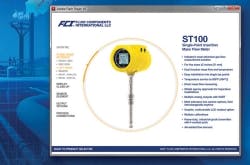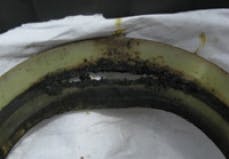Preventing Failures by Selecting the Right Flange Isolation Kit
By John T. Keldsen
Flange isolation kits are used to seal and electrically insulate flanges, thereby maintaining the integrity of piping systems. By preventing metal-to-metal contact, they mitigate corrosion caused by galvanic action or when used in conjunction with a cathodic protection system.
Flange isolation kits consist of gaskets to separate flanges in metallic piping systems, plus non-conductive sleeves and washers to prevent the flow of electric current across the connection. However, these kits can fail if they are not properly specified, manufactured and installed. Following are a few such examples, the first two of which involve isolating gaskets that failed.
The retainer material for the gasket in Figure 1 was not cut from a sheet as large as the flange on which it was installed. The material had to be spliced together. The overlapping seam which is subject to separation under pressure indicates the splice was poorly made. As a result, the gasket failed during hydrostatic pressure testing.
The gasket in Figure 2 split at the sealing location due to improper sizing and/or the durometer of the rubber sealing element.
To avoid these types of failures, the following factors should be considered when specifying flange isolation kits. Gainsaying the conventional wisdom that gaskets with overlapping seams should be avoided is the fact that a number of these have been in service for many years without failures. The issue with this type of gasket is generally not the seams, but controlling tolerances and adhering to exacting design, quality and raw material standards.
As an example, both of the failed gaskets above were replaced with PSI LineBacker® gaskets from Pipeline Seal & Insulator, which worked as designed.
The globalization of sourcing has brought with it inexpensive materials that ostensibly meet the requirements for flange isolation gaskets, but may not be functional or effective for their intended use. For example, there are numerous phenolic formulations that have not been properly evaluated for suitability as a gasket material. Some are more porous than others, absorbing water and making them less effective as flange isolation gaskets.
Flange kits also include isolation sleeves to electrically separate the bolts from the flange, as well as non-conductive washers to electrically isolate the nuts securing the bolts. Specifications for isolation sleeves often call for them to be “full length”, an indeterminate measure for which there is no known industry standard. In practice the sleeves should extend at least halfway into the steel backup washers behind the isolation washers.
Figure 3 shows a sleeve that failed in shear mode. The contractor ordered glass-reinforced epoxy isolation washers and sleeves from one supplier and steel washers from another. Normally the isolation and steel washers are supplied as part of a kit. Because the I.D. of the steel washers was slightly smaller than the isolating washers, there was no clearance between the steel washers and the sleeve. As the nuts were tightened, they grabbed the sleeves and twisted them causing the failure. Both the I.D.s and O.D.s of the steel and isolation washers should have been precisely matched for more uniform loading and to allow the sleeve to fit within the I.D. of the steel washer.
In Figure 4 the compressive load of the blue steel washer (second from the bottom) has squeezed out the white isolation washer, the result of exceeding the compressive strength of the washer material and the dimensional variance between the two washers.
Flange isolation kit failures can largely be avoided by taking into account the factors that contributed to them in the above examples, notably gasket quality. The isolating gaskets are critical to the performance of these kits and the piping systems they are designed to protect. As such, they should be specified with the same care as other system components.
About the author: John T. Keldsen is Director of Sales and Marketing at PSI/Pikotek, Houston, TX.




